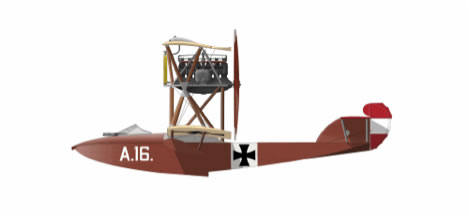|
German Seaplane Fighters of WWI
by Jack Herris

Aeronaut Books
S u m m a r y |
| Publisher and Title: |
German Seaplane Fighters of WWI by Jack Herris
Aeronaut Books |
| Media: |
141 pages. Available in both iBook and PDF formats |
| Price: |
USD$7.99 PDF version online from Aeronaut Books
USD$7.99 for iBook Version from Apple Store |
| Review Type: |
First Read |
| Advantages: |
Very interesting text and impressive collection of period images; competent colour profiles and paintings; tabulation of production quantities, serial numbers and technical specifications. |
| Disadvantages: |
|
| Conclusion: |
This is a publication that describes the development of German Navy seaplanes in WWI. It does so through the use of contemporary photos, illustrations, and free flowing text. The origins and evolution of these single-seat floatplanes and flying boats are discussed as well as the 2-seat biplanes and monoplanes. The result is an excellent overview of how these fascinating aircraft came to be. |
Reviewed by Rob Baumgartner

HyperScale is proudly supported by Squadron.com
E-books are becoming more and more popular these days.
By using this format authors are able to have their work published at a lesser cost than that of printed matter. Jack Herris has decided to enter this medium and “German Seaplane Fighters of World War One” is his second foray into the electronic world.
-
Chapter 1 covers the introduction and discusses the origins of the subject aircraft and why such machines were needed in the first place. The premise of attaching floats and the subsequent development of the fighter concept is also looked at. All this allows the reader to best understand the designs that are presented in the pages that follow.
There is also a detailed look at the Friedrichshafen FF33L, which was the transitional design to the Navy’s two-seat fighters.

-
Chapter 2 is about single seat floatplanes and here we find descriptions on the Albatros W4, Brandenburg KDW series, Rumpler 6B1 & 6B2, Friedrichshafen FF43, Roland W1, Sablatnig SF4, L.T.G. FD1, and the innovative retractable float design of the Ursinus.
A generous helping of period photographs compliment the text and allows the reader to put each aircraft into perspective. In fact there are a total of 167 images spread throughout the publication, with these generally being presented as one or two per page.
The competent work of Bob Pearson also makes a welcome appearance. There a 25 colour profiles for the reader to enjoy and the visual pleasure continues with 5 paintings by Steve Anderson.
-
Chapter 3 deals with the “Flying Boat Fighters” and as such concentrates on the Brandenburg CC. The German Navy generally preferred to use floatplanes as fighters and thus this flying boat can be considered as a bit of an anomaly. The Austro-Hungarian versions were more powerful than their German counterparts and therefore proved very popular with those pilots.
-
Chapter 4 is the home of the two-seat biplane fighters. The need for longer range and better combat effectiveness led to the development of these aircraft. The Albatros W8, superb Brandenburg W12, W19, W27, and W32, as well as the Friedrichshafen FF48, Sablatnig SF3, SF7 all feature in this expose
-
Chapter 5 is all about the 2-seat monoplanes which were introduced as a way of increasing the aircraft’s speed. Naturally the Brandenburg W29 takes centre stage but the larger W33, W34 and W37 also get a mention, as does the Friedrichshafen FF63 and Zeppelin-Lindau (Dornier) CS.I
-
Chapter 6 sees the author take a retrospective look at the roles that all of the aforementioned aircraft types played.
I found this publication to be a very easy “book” to read.

It allows the reader to gain an overall understanding of German seaplane fighters (and their development) without getting the enthusiast bogged down in a myriad of technical details. If you want more detailed information on specific types, there are other sources to be had and the author gives these in his bibliography.
The publication is available in both iBook and PDF formats and its 141 pages should be of interest to all enthusiasts of German WWI Naval aviation.
Thanks to Jack Herris for the review sample

Review Copyright © 2012 by Rob Baumgartner
This Page Created on 1 August, 2012
Last updated
1 August, 2012
Back to HyperScale Main Page
Back to Reviews Page
|
